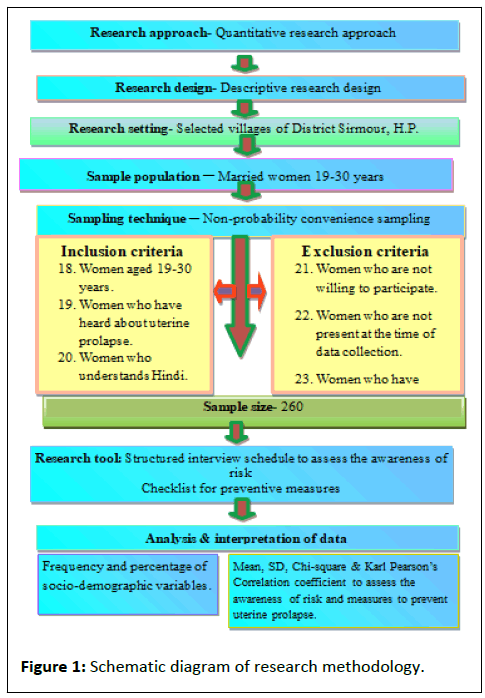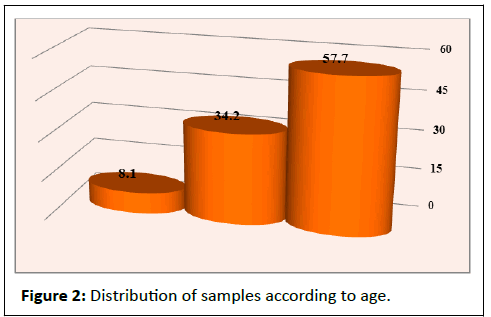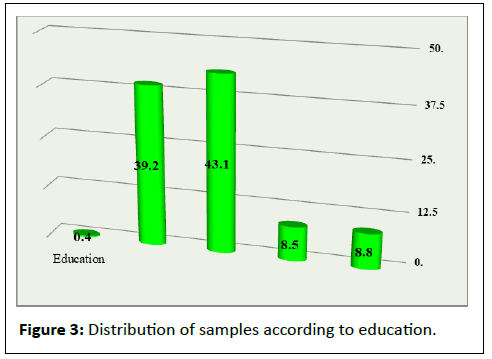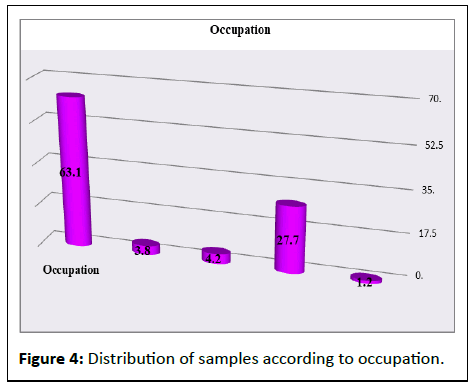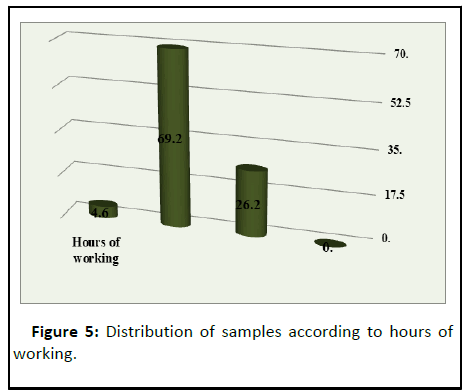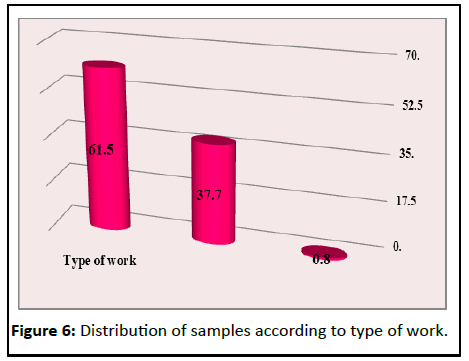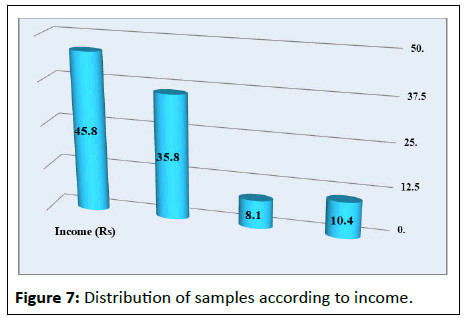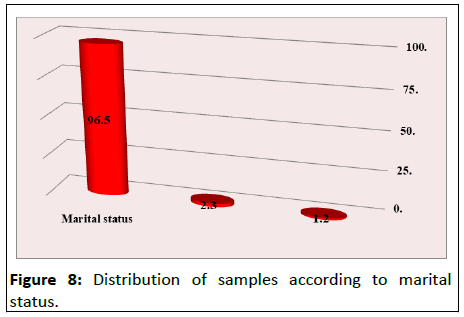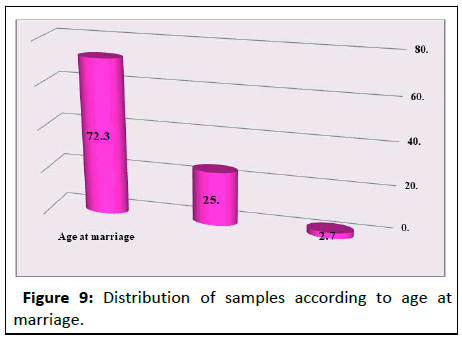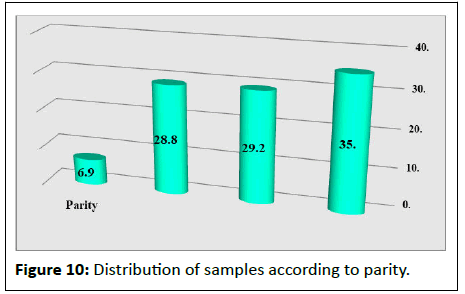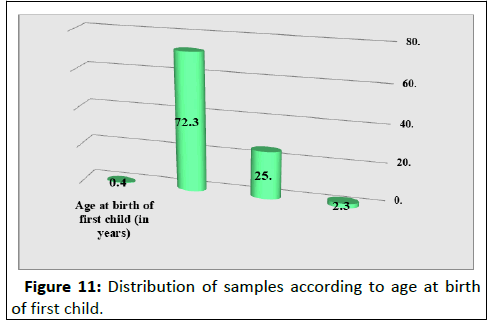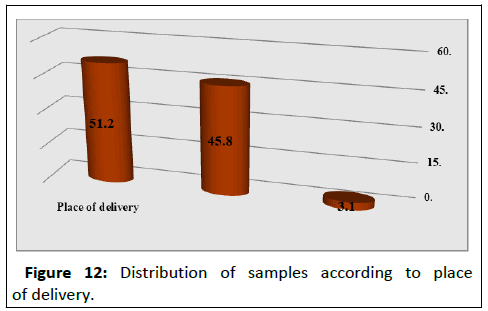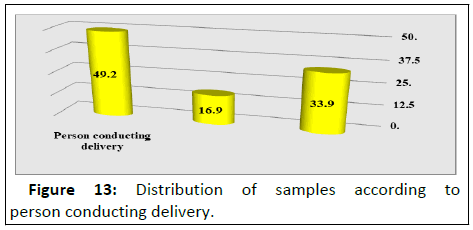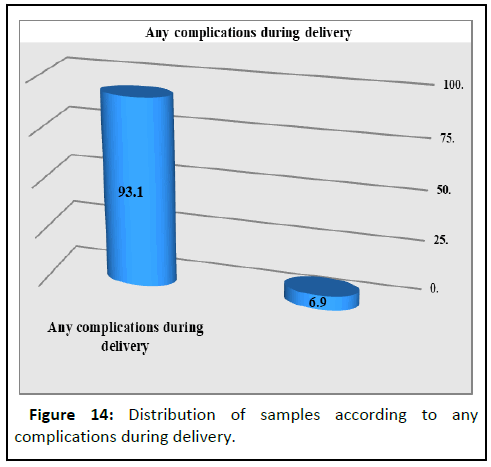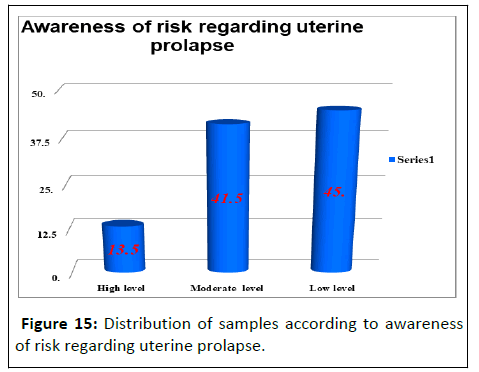Assessment of Awareness of Risks to Prevent Uterine Prolapse among Young Married Women in Selected Villages of District Sirmour, Himachal Pradesh
Suchpreet Kaur Gill1*, Gurjyot Kaur2, Komal Preet1, Nitika Kaushal1 and Neelam Kaur1
1Department of Public Health, Eternal University, Himachal Pradesh, India
2Department of Public Health, Baba Ghulam Shah University, Jammu, India
- *Corresponding Author:
- Suchpreet Kaur Gill
Department of Public Health,
Eternal University,
Himachal Pradesh,
India;
Email: suchpreet@eternaluniversity.edu.in
Received: January 22, 2020 Manuscript No. IPJPM-23-3244; Editor assigned: January 27, 2020, PreQC No. IPJPM-23-3244 (PQ); Reviewed: February 10, 2020, QC No. IPJPM-23-3244; Revised: October 18, 2023, Manuscript No. IPJPM-23-3244 (R); Published: November 15, 2023, DOI: 10.36648/2572-5483.8.6.220
Citation: Gill SK, Kaur G, Preet K, Kaushal N, Kaur N (2023) Assessment of Awareness of Risks to Prevent Uterine Prolapse among Young Married Women in Selected Villages of District Sirmour, Himachal Pradesh. J Prev Med Vol.8 No.6:220
Abstract
Introduction: Pelvic organ prolapse is one of the common clinical conditions met in day-to-day gynaecological practice, especially amongst parous women. A study was conducted to assess awareness of risk to prevent uterine prolapse among young married women in selected villages of district Sirmour, Himachal Pradesh.
Objectives: To assess the awareness of risk regarding uterine prolapse and to find out association of the awareness of risk findings with selected demographic variables.
Methods: Quantitative research approach using descriptive research design was used. Non-probability convenience sampling was opted to get sample of 260 married women of 19-30 years age group from selected villages of district Sirmour, H.P. Structured interview schedule was used to assess the awareness of risk.
Results: The results showed that about 45% of women had low level knowledge, 41.5% had moderate level and 13.5% remaining had high level awareness regarding risk of uterine prolapse. There was a significant relationship between education, occupation, hours of working, type of work, age at marriage, age at birth of first child, place of delivery, person conducting delivery with awareness of risk regarding uterine prolapse.
Conclusion: With the changing health trends, it must emphasize on primary health care approach focusing on prevention rather than cure. Awareness programmes regarding risk factors to prevent uterine prolapse should be organised at regular intervals. In order to prevent uterine prolapse, proper health care during antenatal, intra-natal and postnatal period should be provided.
Keywords
Uterine prolapse; Risks; Prevention; Awareness; Married women
Introduction
The uterus is not in an affixed position in pelvis. Sharmilla discussed that minor variations in position occur with changes in posture with straining and with full bladder or rectum. Pelvic organ prolapse is one of the common clinical conditions met in day-to-day gynaecological practice, especially amongst various women.
Uterine prolapse (also called a fallen uterus or uterine descensus) is generally a by-product of aging, injury to vaginal tissues or both. It is most common in women who have delivered babies vaginally, particularly if they have had many children or experienced long or difficult labours or deliveries (which increase the chances of permanent damage to the pelvic support structures). In addition to childbirth, excessive abdominal pressure or stress can weaken pelvic support. For this reason, some jobs requiring heavy lifting can predispose women to uterine prolapse [1].
Lowdermilk, et al., found out that uterine prolapse is a more serious type of displacement. The degrees of prolapse vary from mild to complete. Uterine displacement and prolapse can be caused by congenital or acquired weakness of the pelvic support structures (often referred to as pelvic relaxation). The contributing causes of uterine prolapse are pelvic trauma, stress, strain and the aging process. The female genital organs are maintained in their normal anatomical position by a number of fascial condensations (endopelvic fascia) referred to as ligaments, especially the transverse cervical (cardinal) and uterosacral ligaments. Ojiyi, et al., mentioned that weakness in any of these supportive structures leads to uterine descent, particularly around the period of menopause when estrogen withdrawal causes a second insult to the integrity of the pelvic supports already weakened by repeated vaginal deliveries. Hence, childbirth and aging constitute the most important associated factors of female genital prolapse [2].
According to Hoffmann, et al., pelvic organ prolapse is a health concern affecting millions of women worldwide. In the United States, it is the third most common indication for hysterectomy. The estimation of disease prevalence has been hampered by lack of a consistent definition of pelvic organ prolapse. If the validated Pelvic Organ Prolapse Quantification (POP-Q) examination alone is used to describe pelvic organ support, 30% to 65% of women presenting for routine gynaecologic case have stage 2 prolapse. Pelvic organ prolapse has a high overall prevalence of 46% in the well-defined population of rural Gambian women. Scherf, et al., survived that 14% had a serious degree of prolapse warranting surgical intervention. The survey’s high participation rate among the eligible women resident in the study area makes this an accurate assessment of the largest population of women studied to date. It was found that high parity is the single most important risk factor for prolapse in rich and poor women in both more and less developed countries [3].
The study revealed that the higher burden of uterus prolapse is found in those with poor economic background, those aged above 30 years and with more than two deliveries conducted at home. Binjwala, et al., study concluded that 53% of the women in this study had never heard about uterine prolapse. The age of respondents, occupation, age at first birth, place of delivery, work load during the peurperium period, time to resume work after delivery, number of delivery and person providing assistance during delivery were the key associated factors. In most cases, ring pessary was applied and significant improvement in their health was reported. However, 69% had not used any treatment mainly due to poor socioeconomic status. Therefore, it was recommended that uterine prolapserelated health promotion programs should target women in all caste/ethnic groups, age groups and education status nationwide, including both urban and rural communities [4].
Statement of the problem
A descriptive study to assess awareness of risk to prevent uterine prolapse among young married women in selected villages of district Sirmour, Himachal Pradesh.
Aim
To assess awareness of risk to prevent uterine prolapse among young married women.
Objectives
• To assess the awareness of risk regarding uterine prolapse.
• To find out association of the awareness of risk findings with
selected demographic variables.
Operational definitions
Awareness: It means the factual information that a person
knows and is measured by correct responses obtained from
women regarding risk of uterine prolapse.
Measures: A plan or action adopted by a women regarding
prevention of uterine prolapse.
Uterine prolapse: It means sliding down of the uterus from
the vagina in the women having uterine prolapse.
Married women: It refers to those women aged between
19-30 years residing at selected villages of district Sirmour,
Himachal Pradesh.
Materials and Methods
Research approach
The quantitative research approach was used in this research study. Questionnaires with set questions and answers were given away to the respondents who responded from the options asked. This research approach focused on how people feel and what they think [5].
Research design
Non-experimental descriptive design was used as a research design. The purpose of descriptive studies is to observe and describe aspects of a situation as it naturally occurs. A descriptive design provides an accurate portrayal or account of characteristics of a particular individual, situation or group. In this study, data was collected on the awareness of risk to prevent uterine prolapse [6].
Variables
Demographic variables: The demographic variables in this study were age of the respondents, education, occupation, hours of working, type of work, income, marital status, age at marriage, parity, age at birth of first child, place of delivery, person conducting delivery and any complications during delivery.
Research variables: The research variable in this study was risk to prevent uterine prolapse.
Research setting
The research setting for the study was the selected villages- Dimber, Nanu, Lana Balta, Kheri, Macher, Banog and Rajgarh of district Sirmour, H.P.
Population
The population comprised of married women aged 19-30 years from selected villages of district Sirmour, H.P.
Criteria for sample selection
Inclusion criteria:
• Women aged 19-30 years.
• Women who have heard about uterine prolapse.
• Women who understands Hindi.
Exclusion criteria:
• Women who are not willing to participate.
• Women who are not present at the time of data collection.
• Women who have uterine prolapse.
Sampling technique
Non-probability convenience sampling technique has been used to select the sample for the study as they were easy to my reach and are accessible [7].
Sample size
260 samples had been selected in my study according to the prevalence rate. The sample size was calculated using the formula:
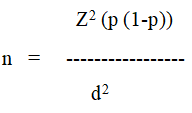
Where, n is the size of sample; Z is the z-statistics for the desired level of confidence; p is the estimate of expected proportion with the variable of interest in the population; d is the half width of the desired interval (precision) (1.96)2 × 0.20 × 0.8/(0.05)2 3.84 × 0.20 × 0.8/0.0025=245 Calculated sample size=245 Study sample=260 The sample size was increased to prevent bias.
Development and description of tool
The structured interview schedule was developed by the investigator to assess the awareness of risk regarding uterine prolapse. Preparation of the tool was done by
• Review of literature
• Discussion with guide and nursing experts
The tool consisted of the following sections:
Section A: Demographic variables such as age of the respondents, education, occupation, hours of working, type of work, income, marital status, age at marriage, parity, age at birth of first child, place of delivery, person conducting delivery and any complications during delivery [8].
Section B: Structured interview schedule to assess awareness of risk regarding uterine prolapse. This section consisted of 12 questions. A score of 1 was given for correct response (yes) and 0 for incorrect response (no). The scores were categorised using modified blooms cut off point as:
• High level: 80%-100%
• Moderate level: 50%-79%
• Low level: <50%
Content validity
Validity of tool was done by 5 external experts from nursing and medicine to check the content validity. Internal validation was done by five experts: 5 assistant professors of Akal college of nursing, Baru Sahib. External validation was done by five experts: 4 assistant professor (SNGNC Shimla) and 1 professor (Kamla Nehru hospital, Shimla).
Relevant modifications were made as per suggestions of the experts and the changes were incorporated in the tool.
Reliability of the tool
The Karl Pearson’s correlation coefficient was used to assess the awareness of risk to prevent uterine prolapse. With a correlation coefficient value i.e., r=0.7, it was strongly positively correlated and there it was concluded that the tool was reliable. Internal consistency was evaluated by using split half method.
Pilot study
Pilot study was conducted to find the feasibility of the tool after obtaining formal permission from the concerned authority. The data was collected from 26 respondents by using structured interview at selected village of district Sirmour-Bagroti in the month of November through non-probability convenience sampling technique.
The samples that are included in pilot study were not included in the main study. The tool was found reliable with reliability score of 0.70.
Procedure of data collection
After obtaining permission from the concerned authorities; informed written consent from the selected respondents, the investigator collected the data pertaining to the demographic variable.
Data was collected by using close ended questions in the form of structured interview. Interview was carried out to get the information. It took 15 minutes to collect data from each sample. Each day 9 samples were taken (Figure 1) [9].
Plan for data analysis
The data collected was grouped and analysed by descriptive and inferential statistics.
Descriptive statistics:
• Frequency and percentage distribution of selected
demographic variables.
• Frequency and percentage distribution of awareness of risk
findings regarding uterine prolapse.
Inferential statistics:
• The association between selected demographic variables and awareness of risk findings will be analysed by using chi square.
Results
Data analysis and interpretation
This chapter deals with the detailed description of the findings obtained from the analysis of observations. The gathered data was first coded and summarised in a master sheet and then analysed by using Statistical Package for Social Sciences (SPSS 15). The variables were described in percentages, means and standard deviation, depending on the nature of the variables. After obtaining results from data analysis the discussion was done which is described in terms of results of the current study and comparing it with previous studies [10].
It deals with the analysis and interpretation of data, collected from 260 respondents regarding awareness of risk and measures to prevent uterine prolapse. The data was organised, analysed and interpreted by using descriptive and inferential statistics. Analysis and interpretation was done based on objectives of the study. In current study, data analysis is described in the following sections:
Section A: Frequency and percentage distribution of
demographic variables of the sample.
Section B: Assessment of awareness of risk findings regarding
uterine prolapse among married women.
Section C: Association between awareness of risk findings
with selected demographic variables.
Section A: Frequency and percentage distribution of demographic variables of the samples
This section depicts about the profile of the samples. The socio demographic profile includes age, education, occupation, hours of working, type of work, income, marital status, age at marriage, parity, age at birth of first child, place of delivery, person conducting delivery and any complications during delivery (Figures 2-14).
Section B: Assess awareness of risk findings regarding uterine prolapse among young married women.
This section includes a structured interview schedule to assess awareness of risk regarding uterine prolapse. The samples answered a total of 12 close ended questions. Each correct response was given one mark and 0 score for incorrect response with a maximum of 12 marks (Table 1) [11].
| Sr. no. | Questions | Aware | Not aware | ||
|---|---|---|---|---|---|
| f | % | f | % | ||
| 1 | How will you recognize uterine prolapse? (yes=something coming out of vagina, No=others) | 90 | 34.6 | 170 | 65.4 |
| 2 | Do you think delivery by untrained birth attendants is a risk of uterine prolapse? (Yes=Aware, No=Not aware) | 206 | 79.2 | 54 | 20.8 |
| 3 | Do you think heavy lifting is a risk of uterine prolapse? (Yes=Aware, No=Not aware) | 243 | 93.5 | 17 | 6.5 |
| 4 | Do you think prolonged labor for 18 hours is a risk of uterine prolapse? (Yes=Aware, No=Not aware) | 175 | 67.3 | 85 | 32.7 |
| 5 | Do you think doing heavy work during post natal period till 42 days is a risk for uterine prolapse? (Yes=Aware, No=Not aware) | 221 | 85 | 39 | 15 |
| 6 | Do you think inadequate diet during pregnancy cause uterine prolapse? (Yes=Aware, No=Not aware) | 111 | 42.7 | 149 | 57.3 |
| 7 | Do you think chronic cough for more than 1year is a risk for uterine prolapse? (Yes=Aware, No=Not aware) | 135 | 51.9 | 125 | 48.1 |
| 8 | Do you think constipation is a risk factor for uterine prolapse? (Yes=Aware, No=Not aware) | 155 | 59.6 | 105 | 40.4 |
| 9 | Does overweight is a risk for uterine prolapse? (Yes=Aware, No=Not aware) | 99 | 38.1 | 161 | 61.9 |
| 10 | Do you think giving birth to more than 2 children is the major risk for uterine prolapse? (Yes=Aware, No=Not aware) | 65 | 25 | 195 | 75 |
| 11 | Do you think giving birth to large baby is a risk for uterine prolapse? (Yes=Aware, No=Not aware) | 69 | 26.5 | 191 | 73.5 |
| 12 | Do you think trauma/injury during child birth is a risk for uterine prolapse? (Yes=Aware, No=Not aware) | 23 | 8.8 | 237 | 91.2 |
Table 1: Frequency and percentage distribution of awareness of risk findings regarding uterine prolapse.
This table reveals that about 90 (34.6%) women were aware and 170 (65.4%) were not aware regarding recognizing uterine prolapse, delivery by untrained birth attendants is a risk of uterine prolapse was aware to about 206 (79.2%) but 54 (20.8%) were not aware, majority of women 243 (93.5%) were aware that heavy lifting is a risk of uterine prolapse as compared to 17 (6.5%) were not aware regarding it, about 175 (67.3%) were aware and 85 (32.7%) were not aware that prolonged labor for 18 hours is a risk of uterine prolapse, doing heavy work during post natal period till 42 days was aware to 221 (85%) as 39 (15%) were not aware regarding this as a risk factor, about 111 (42.7%) were aware and 149 (57.3%) were not aware that inadequate diet during pregnancy cause uterine prolapse. About 135 (51.9%) women were aware that constipation is a risk factor for uterine prolapse as 125 (48.1%) were not aware. More than half of the women 161 (61.9%) were not aware but 98 (38.1%) were aware of that overweight is a risk for uterine prolapse. Around 65 (25%) were aware as 195 (75%) were not aware that giving birth to more than 2 children is a major risk for uterine prolapse, giving birth to large baby was aware to 69 (26.5%) but 191 (73.5%) were not aware is a risk factor. Majority of women 237 (91.2%) were not aware that trauma/injury during childbirth is a risk for uterine prolapse as 23 (8.8%) were aware regarding it (Table 2).
| Variable | Level | f | % |
|---|---|---|---|
| Awareness of risk regarding uterine prolapse | High level | 35 | 13.5 |
| Moderate level | 108 | 41.5 | |
| Low level | 117 | 45 |
Table 2: Distribution of awareness of risk regarding uterine prolapse according to levels by modified Bloom’s cutt off point.
Modified blooms cut off points were used to determine awareness level. A total of 12 yes/no questions were prepared by reviewing the different sources of literature. A score of 1 was given for each correct response and 0 score for incorrect response. Based on the sum scores, level of awareness of risk was classified into low level awareness (<50%), moderate level awareness (50%-79%) and high level awareness (80%-100%).
About (45%) had low level (<50%) of awareness, 41.5% of them had moderate level of awareness (50%-79%) and remaining 13.5% of them had high level of awareness (80%-100%) of risk regarding uterine prolapse. Therefore, nearly 86.5% of the women in this study had a low to moderate level of awareness about the awareness of risk regarding uterine prolapse (Figure 15) [12].
Section C: Association between awareness of risk findings with selected demographic variables
This section includes association between awareness of risk findings with selected demographic variables as age, education, occupation, hours of working, type of work, income, marital status, parity, age at marriage, age at birth of irst child, place of delivery, person conducting delivery and any complications during delivery which is calculated by chi square (Table 3).
| Variables | Awareness of risk | |||
|---|---|---|---|---|
| χ2 | df | t value | Sig (0.05) | |
| Age | 4.97 | 4 | 9.49 | 0.29 |
| Education | 17.191 | 8 | 15.51 | 0.028 |
| Occupation | 21.233 | 8 | 15.51 | 0.007 |
| Hours of working | 19.592 | 4 | 9.49 | 0.001 |
| Type of work | 15.574 | 4 | 9.49 | 0.004 |
| Income | 11.578 | 6 | 12.59 | 0.072 |
| Marital status | 2.954 | 4 | 9.49 | 0.566 |
| Parity | 12.231 | 6 | 12.59 | 0.057 |
| Age at marriage | 18.266 | 4 | 9.49 | 0.001 |
| Age at birth of first child | 23.143 | 6 | 12.59 | 0.001 |
| Place of delivery | 31.067 | 6 | 12.59 | 0 |
| Person conducting delivery | 18.394 | 6 | 12.59 | 0.002 |
| Any complications during delivery | 1.973 | 2 | 5.99 | 0.373 |
Table 3: Association between awareness of risk findings with selected demographic variables.
This table depicts that there was a significant relationship between education, occupation, hours of working, type of work, age at marriage, age at birth of first child, place of delivery, person conducting delivery with awareness of risk regarding uterine prolapse.
It was also observed that there was no significant relationship between age, income, marital status, parity, any complications during delivery with awareness of risk regarding uterine prolapse.
Discussion
The discussion deals with the findings of the study. The findings of the each objective are as follows:
Assess awareness of risk regarding uterine prolapse. In this study it was found that majority 90 (34.6%) women were aware regarding recognising uterine prolapse, delivery by untrained birth attendants is a risk of uterine prolapse was aware to about 206 (79.2%), a large number of women 243 (93.5%) were aware that heavy lifting is a risk of uterine prolapse as, about 175 (67.3%) were aware that prolonged labor for 18 hours is a risk of uterine prolapse, doing heavy work during post natal period till 42 days was aware to 221 (85%) regarding this as a risk factor, about 111 (42.7%) were aware that inadequate diet during pregnancy cause uterine prolapse. About half of the women 135 (51.9%) were aware that constipation is a risk factor for uterine prolapse, only 98 (38.1%) women were aware of that overweight is a risk for uterine prolapse, around 65 (25%) were aware that giving birth to more than 2 children is a major risk for uterine prolapse, giving birth to large baby was aware to 69 (26.5%) is a risk factor, trauma/injury during childbirth is a risk for uterine prolapse as 23 (8.8%) women were aware regarding it.
In a study conducted by Baruwal, found that the majority of respondents had knowledge that delivery by untrained birth attendants (80.5%) and carrying heavy load during pregnancy (80.5%) cause uterine prolapse. Nearly 90% of the respondents answered that doing heavy work during pre and post natal period cause uterine prolapse. More than 50% of women disagreed with the statement that having many children reduces the risk of uterine prolapse. About (32%) women think that having not enough food during pregnancy causes uterine prolapse and 52.3% think that undergoing labor for long period causes uterine prolapse.
In the present study chi square test was used to calculate the association between awareness of risk with selected variables. Results of present study reveals there is significant association between selected variables as education (p=0.028), occupation (0.007), hours of working (p=0.001), type of work (p=0.004) age at birth of first child (p=0.001), place of delivery (p=0.000) and person conducting delivery (p=0.002)) with awareness of risk regarding uterine prolapse at p<0.005. Hence research hypothesis for this study was accepted.
This study is supported by the results of the study conducted by Baruwal found out the association with chi-square and it reveals that the relationship between education and status of prolapse was not significant (p=0.65), even there is no significant difference (p=799) between occupation and status of uterine prolapse. There is no significant difference between place of delivery (p=183), delivery practices (p=114) and status of uterine prolapse [13].
Conclusion
Uterine prolapse affects women both in the child bearing age and post-menopausal period. As pregnancy and childbirth are such physiological phenomenon which cannot be prevented but we can prevent the repeated pregnancies at short intervals and deliveries by untrained dais at home. Thus multi-parity, prolonged labour, deliveries by untrained dais, less spacing between children are significant determinants.
Ethical Consideration
The permission was obtained from the principal, Akal college of nursing Baru Sahib. Permission was taken from the Pradhans of various panchayats prior to collection of data. Informed written consent was obtained from the study participants before the collection of information. The purpose of the study was explained to the subjects in their own language and confidentiality of the information was ensured.
References
- Ojiyi EC, Dike EI, Anolue FC, Okeudo C, Nzewuihe AC, et al. (2013) Uterovaginal prolapse at a university teaching hospital in South-East Nigeria. Orient J Med 25: 107-112.
- Scherf C, Morison L, Fiander A, Ekpo G, Walraven G (2002) Epidemiology of pelvic organ prolapse in rural Gambia, West Africa. Int J Gynaecol Obstet 109: 431-436.
[Crossref] [Google Scholar] [PubMed]
- Bijalwan RP, Bhagavatula M, Semwal VD, Rawat P, Anand V (2015) Morbidity of uterine prolapsed among the women in the Chakrata block of Dehradun district. Indian J Comm Health 27: 103-109.
- Patil P, Patil A (2013) Evaluation of pelvic organ prolapse in indian females. J Evol Med Dent Sci 2: 7612-721.
- Choudhary DK, Garkoti SC (2017) Transhumant pastoralism in Indian western Himalaya: traditional ecological knowledge and contemporary practices. Int J Sustain Develop World Ecol 17: 1-4.
- Radl CM, Rajwar R, Aro AR (2012) Uterine prolapse prevention in Eastern Nepal: The perspectives of women and health care professionals. Int J Womens Health 31: 373-382.
[Crossref] [Google Scholar] [PubMed]
- Parajuli S, Lawot I (2020) Awareness on uterine prolapse among parous women in Pokhara, Kaski. J Allied Health Sci 10: 46-51.
- Islam JY, Khatun F, Alam A, Sultana F, Bhuiyan A, et al. (2018) Knowledge of cervical cancer and HPV vaccine in Bangladeshi women: A population based, cross-sectional study. BMC Women's Health 18: 1-3.
[Crossref] [Google Scholar] [PubMed]
- Rashad M, Fadel E, El-Nemer A (2018) Women's knowledge regarding pelvic organ prolapse. Mansoura Nursing J 5: 57-67.
- Awwad J, Sayegh R, Yeretzian J, Deeb ME (2012) Prevalence, risk factors and predictors of pelvic organ prolapse: A community-based study. Menopause 19: 1235-1241.
[Crossref] [Google Scholar] [PubMed]
- Prasad JH, Abraham S, Kurz KM, George V, Lalitha MK, et al. (2005) Reproductive tract infections among young married women in Tamil Nadu, India. Int Fam Plan Perspect 1: 73-82.
[Crossref] [Google Scholar] [PubMed]
- Mohammed SA, Mahmoud GA, Abd-Elhafeez ER (2020) Educational program for primiparous women about postpartum preventive measures of genital prolapse at woman's health hospital. Assiut Sci Nurs J 8: 134-143.
- Hasan F, Alam MM, Hossain MG (2019) Associated factors and their individual contributions to caesarean delivery among married women in Bangladesh: Analysis of Bangladesh demographic and health survey data. BMC Preg Childbirth 19: 1-9.
[Crossref] [Google Scholar] [PubMed]
Open Access Journals
- Aquaculture & Veterinary Science
- Chemistry & Chemical Sciences
- Clinical Sciences
- Engineering
- General Science
- Genetics & Molecular Biology
- Health Care & Nursing
- Immunology & Microbiology
- Materials Science
- Mathematics & Physics
- Medical Sciences
- Neurology & Psychiatry
- Oncology & Cancer Science
- Pharmaceutical Sciences
